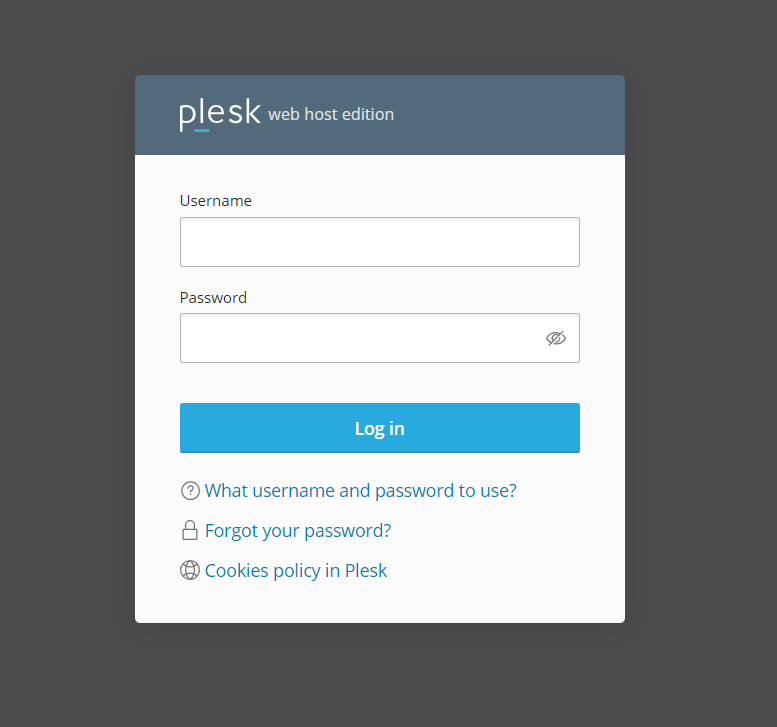Plesk is a powerful and widely used control panel for managing hosting environments, making it easier to handle PHP settings, databases, and mail servers. For developers, webmasters, or anyone managing websites, it’s important to know how to access and check these settings to ensure everything runs smoothly. In this blog post, we’ll guide you step-by-step through checking the PHP, database, and mail server settings in the Plesk panel.
Table of Contents
Why It’s Important to Check These Settings
- PHP settings control how your server processes PHP scripts, affecting website performance and compatibility.
- Database settings help manage the backend structure of your site, critical for content management systems (CMS) like WordPress, Joomla, etc.
- Mail server settings ensure email communication from and to your domain runs without any issues.
Step 1: Checking PHP Settings in Plesk
Log in to Plesk

Start by logging into your Plesk account. Use the credentials provided by your hosting provider.
Go to PHP Settings
Once you’ve logged in:

- Navigate to Websites & Domains.
- Find the domain for which you want to check or configure the PHP settings.
- Click on PHP Settings.
Here, you’ll see the current PHP version, execution limits, memory limits, and other options you can tweak based on your website’s requirements.
Common PHP Settings to Check

- PHP Version: Always ensure you’re using the latest stable version of PHP for security and performance.
- Memory Limit: Check the memory limit to ensure your site has enough resources for intensive tasks like content management systems.
- Post Max Size: This setting controls the size of the POST data, particularly useful for file uploads.
- Execution Time: Modify this if your scripts take longer to execute than the default setting allows.
Changing PHP Version
If you want to change the PHP version:
- Go to PHP version dropdown.
- Select the version you prefer and click Apply or OK.
Step 2: Checking Database Settings in Plesk
Navigate to the Database Section

- Go to Websites & Domains from the main dashboard.
- Scroll down and click on Databases. Here, you will see all the databases associated with your account.
View Database Settings
To view detailed settings:
- Click on the database name.
- You can manage users, set privileges, and even change passwords for the database.
phpMyAdmin Access
To further check or modify database contents:
- Click on phpMyAdmin next to the database.
- This opens the phpMyAdmin tool, where you can view tables, perform queries, or import/export data.
Important Database Settings to Review
- Database Engine: Confirm whether your database is using MySQL or MariaDB.
- Charset and Collation: Ensures your database is set up to handle different languages and special characters.
- Database Size: Keep track of the size to ensure your hosting plan has adequate space.
Step 3: Checking Mail Server Settings in Plesk
Go to Mail Settings

- In the Websites & Domains tab, click on Mail.
- This brings up a list of email addresses associated with your domains.
Mail Server Configuration
To check or configure the mail server settings:

- Go to Tools & Settings on the left-side menu.
- Under Mail, click on Mail Server Settings.
Key Mail Settings to Check
- SMTP Server: The outgoing mail server settings, usually configured to send emails from your domain.
- IMAP/POP3 Settings: These are important if you want to receive mail via a mail client.
- Mail Queue: Check the mail queue to monitor outgoing emails.
- Spam Filters: Ensure spam filters are active to prevent unwanted mail from reaching your inbox.
- DKIM and SPF: Enable these features to authenticate emails sent from your domain and avoid them being marked as spam.
Configuring a New Email Address
To create a new email account:
- Go to the Mail section.
- Click Create Email Address and fill in the details like email address, password, and mailbox size.
Additional Tips for Managing PHP, Database, and Mail Settings
Monitoring Resource Usage
Keep an eye on the resource usage for both PHP and databases:
- Monitoring CPU and Memory: Use the Monitoring tool in Plesk to track how much CPU and memory your websites and scripts are consuming.
Backup Your Database Regularly
Before making any significant changes to your PHP or database settings, always perform a backup:
- Go to Databases, click Backup Manager, and create a backup file.
- This ensures that if anything goes wrong, you can restore the database without any data loss.
Updating the Mail Server for Secure Communication
Always ensure your mail server is secure:
- Enable SSL/TLS to encrypt communications.
- Use strong passwords for email accounts to prevent unauthorized access.
Conclusion
By following these steps, you can easily check and configure PHP, database, and mail server settings in Plesk. Keeping these settings optimized ensures your websites run efficiently, your databases are secure, and your emails are delivered without any issues. Whether you’re a beginner or an experienced webmaster, Plesk provides a user-friendly way to manage your hosting environment.
By regularly monitoring and updating your PHP, database, and mail server settings, you’ll maintain a fast, secure, and reliable hosting environment for all your websites.



